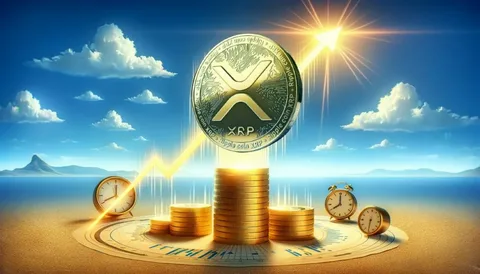Introduction
As the cryptocurrency market matures, Exchange-Traded Funds (ETFs) have emerged as a crucial link between digital assets and traditional finance. ETFs allow investors to gain exposure to assets like Bitcoin and Ethereum without directly holding or managing these cryptocurrencies.
The recent entry of a major player into the XRP ETF race has sparked considerable excitement and curiosity about how this development could impact cryptocurrency investments. XRP, a digital asset tied to Ripple Labs, is known for its unique functionality in cross-border payments and its ambitious approach to improving the global financial system.
Given XRP’s established reputation and strategic applications, the creation of an XRP ETF might mark a significant shift in the way investors approach cryptocurrency, potentially redefining the investment landscape.
This post delves into the implications of this major player’s entry into the XRP ETF race and explores the potential effects on cryptocurrency investments as a whole. We will discuss the background of XRP and ETFs, the significance of this entry, and how it might influence institutional investment, retail interest, and regulatory landscapes. By the end, readers will have a clear understanding of why the XRP ETF race matters and how it might reshape investment strategies.

1. Understanding the Basics: What Is an ETF and Why Does It Matter for Cryptocurrency Investments?
An Exchange-Traded Fund (ETF) is a financial instrument that pools assets such as stocks, commodities, or cryptocurrencies into a single, tradable security. ETFs are traded on exchanges, providing a simple and relatively low-cost method for investors to gain exposure to various asset classes without directly buying individual assets. In the context of cryptocurrency, ETFs allow traditional investors to gain exposure to digital assets without the complexities of directly holding or managing them.
Cryptocurrency ETFs are particularly attractive for risk-averse investors who want to diversify their portfolios while avoiding the direct volatility and technical challenges of the crypto market. Bitcoin ETFs have already made significant strides in countries like the United States and Canada, setting the stage for the introduction of ETFs based on other cryptocurrencies, such as Ethereum and now XRP. Given XRP’s unique position in the cryptocurrency market, characterized by its focus on streamlined cross-border transactions and institutional partnerships, an XRP ETF has the potential to attract both institutional and retail investors.
In terms of impact, a successful XRP ETF could make cryptocurrency investments more accessible, allowing investors to diversify their portfolios with exposure to XRP’s unique value proposition. This addition could offer several benefits, such as enhanced liquidity for XRP, greater price stability, and increased regulatory oversight, all of which might contribute to its growth and adoption.
2. XRP’s Role in the Crypto Ecosystem: A Unique Investment Proposition
XRP, developed by Ripple Labs, is recognized for its innovative approach to digital payments, offering fast and cost-effective transactions that facilitate seamless international transfers. Unlike Bitcoin and Ethereum, which are decentralized and used for broader purposes, XRP focuses on transforming global financial infrastructure. It has established partnerships with financial institutions and payment providers worldwide, which aim to leverage Ripple’s technology to improve efficiency and reduce transaction costs.
The increasing adoption of XRP among institutional players highlights its value proposition as a unique asset within the cryptocurrency ecosystem. As regulatory clarity around cryptocurrencies continues to evolve, XRP’s close alignment with financial institutions may give it a unique position that could help it gain approval for an ETF.
This ETF would appeal to investors interested in digital finance but seeking a cryptocurrency with tangible use cases and strong institutional backing. Such a unique proposition could lead to substantial institutional inflows, offering a new avenue for cryptocurrency investments.
In addition to its current uses, the proposed XRP could amplify XRP’s potential as a mainstream asset. This could stimulate further interest in cryptocurrencies from traditional finance players, particularly if XRP maintains its positive regulatory trajectory.
For example, in countries where regulatory discussions have signaled a favorable stance on Ripple’s use of XRP, institutional investors might be more inclined to consider XRP-related products. Ultimately, an XRP ETF would place XRP at the forefront of cryptocurrency investments, adding a layer of trust and familiarity for hesitant investors.
3. Implications of a Major Player Entering the XRP ETF Race
The recent announcement of a prominent financial institution entering the XRP race has generated considerable buzz within the investment community. This move signifies that XRP, previously viewed as an alternative cryptocurrency, is now gaining mainstream appeal. The potential approval of an XRP, backed by a reputable financial entity, would offer several key benefits to investors and the broader cryptocurrency market.
- Enhanced Liquidity and Price Stability: its are typically backed by significant institutional capital, which could stabilize XRP’s price by providing a steady source of liquidity. This would reduce price volatility, making XRP a more attractive option for long-term investors.
- Increased Institutional Interest: Institutional investors have traditionally been cautious about cryptocurrency investments, often citing regulatory concerns and volatility as key deterrents. However, the entry of a major player into the XRP race signals growing confidence in XRP as a viable, regulated asset. As a result, more institutions may consider XRP, potentially leading to substantial inflows of capital into the cryptocurrency market.
- Potential Boost for Ripple’s Partnerships: Ripple’s network of institutional partners might also see XRP as a more favorable asset, given its improved accessibility through an ETF. The easier availability of XRP could enhance its integration into traditional financial services, further cementing Ripple’s role in international payments.
- Implications for Other Cryptocurrencies: The approval of an XRP could set a precedent for similar ETFs focused on other cryptocurrencies, especially those with institutional backing and regulatory clarity. If successful, the XRP ETF could spur interest in ETFs for other altcoins, broadening the range of cryptocurrency investment options available to the public.
In conclusion, the participation of a reputable institution in the XRP race indicates confidence in XRP’s stability and compliance with regulatory standards. Such developments could redefine how investors view XRP and its role within cryptocurrency investments, potentially positioning it as a mainstream investment vehicle.
4. The Regulatory Landscape: What the XRP ETF Means for Cryptocurrency Oversight
Regulatory scrutiny has long been a significant barrier to widespread cryptocurrency adoption, particularly for financial products like ETFs. Countries around the world are now grappling with how to integrate cryptocurrencies into traditional finance without compromising regulatory standards. The approval of an XRP could offer a model for how digital assets can be integrated into regulated financial markets, potentially making it easier for other cryptocurrencies to gain approval in the future.
Ripple Labs has been actively working with regulators, which may contribute to XRP’s perceived legitimacy within the financial sector. By aligning itself with regulatory bodies, Ripple seeks to mitigate concerns about compliance, which could be a factor in why an XRP is moving closer to reality. A successful XRP could encourage regulators to take a more favorable view of cryptocurrency investments, potentially creating a pathway for more crypto-based financial products.
Furthermore, the approval of an XRP ETF would signal regulatory approval for a specific cryptocurrency’s unique use case and institutional support, which could serve as a benchmark for other projects. This could lead to a ripple effect in which other cryptocurrencies with similar characteristics might also be considered for ETF inclusion. Such a shift in the regulatory landscape would make cryptocurrencies more accessible, predictable, and suitable for a wider range of investment strategies.
Conclusion
The entry of a major player into the XRP ETF race marks an exciting development for cryptocurrency investments. As we’ve explored, an XRP ETF could significantly impact the investment landscape by increasing liquidity, stabilizing XRP’s price, and potentially driving further institutional interest in the cryptocurrency sector. Additionally, the regulatory implications of such an ETF could pave the way for a more favorable view of cryptocurrencies, providing clearer pathways for new financial products centered around digital assets.
For investors, an XRP ETF represents an opportunity to diversify portfolios with a unique digital asset that bridges the gap between traditional finance and blockchain technology. As this race heats up, it’s likely we’ll see new opportunities, challenges, and developments within cryptocurrency investments. Will XRP lead the way for other altcoins to gain ETF approval? And how will institutional investors respond to this new financial instrument?
Let us know what you think! Share your thoughts on the future of the XRP ETF and its potential impact on cryptocurrency investments in the comments below.



